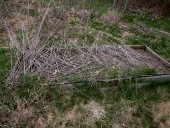Thank you so much for the informative soil building suggestions. I've definitely considered many of these. I found it very helpful to have the soil building plants divided up into "Drillers" "Fillers" and "Biomass" it really helps me get my head around what I'm trying to do. I"ll go through all of the plants put forward and add my thoughts, and add a bit of needed clarification about my goal.
I may not have made it totally clear in my initial post, but within the cover mix I really wanted it to be something that I can plant and walk away from so that I'm still obtaining yield and building soil even if I don't have time to get to a particular portion on on any given year. I frankly have only eaten sunchokes once and they were good, there are a variety of sunchoke preparation strategies that I think I would enjoy. But from a yield perspective they don't seem to be that prolific for online purchasing and I figured I could sell them by the pound online for growing or eating. The lowest I found was $10/pound online and selling them seems like a good option for bringing in some funding for my family and projects--they also seem to sell out later in the season so people are buying them. My precipitation varies greatly from year to year so I am hoping to plant a perennial cover that can handle the drier times as well. The sunchokes are drought tolerant and the lupine has a taproot and is also drought tolerant--plus it also produces an edible lupin bean for animals or people. I got into the lupine idea because of research I found about lupines being grown in rotation with quinoa:
https://www.jstor.org/stable/3673854?seq=1#page_scan_tab_contents. I eventually plan to grow a lot of quinoa because it is well suited for our climate and thought this cover mix would be a good buildup for the eventual quinoa patches.
I'm just going to run through all the perennial ideas that were mentioned and briefly give you my thoughts on them.There are numerous great ideas on this thread for cover crop mixes but I am really focused on the perennial factor and so I won't mention the annuals. I may end up using annuals, but I'm trying to avoid it for this particular system.
Vetch: If the lupine isn't aggressive enough to compete with the sunchokes, this seems like a great second option. It doesn't produce an edible yield like the lupin and subjectively doesn't look as nice, but I do plan on using the lupine flowers as a cut flower income yield as well (I forgot to mention that in my initial post).
Alfalfa: I've considered alfalfa as it is an amazing soil builder, but I had it in my head that it was a heavy water user. But my head was wrong because after looking into that I'm realizing that it can tolerate dry conditions. I will definitely experiment with it in this blend. I have chickens and will have goats so it could be a very productive output. I will have to compare it to the potential yield of the lupine, but this is definitely back on my list of trial cover blends.
Clover: It doesn't quite produce the biomass that I'm looking for, but will still be worth experimenting with on the outskirts of the trial patches to enliven the soil around those areas.
Roots--Daikon/Turnip etc.: I may end up using these with the rape for the first year or two if it seems like I need to. I'll probably do a variety of annuals in the beginning but I really wanted to focus on those crops that would have staying power over the long term so if I set it and forget it, they keep building soil and biomass. After I establish, I want the main plants to keep doing their thing if I'm not able to get to them in a particular year.
Thanks again for all the great info! As I go through this process I'll keep posting updates and progress on this thread so everyone can see how it turns out if you are interested.










